I've been fascinated with Arisaema triphyllum for most of my life, starting when I was 10 years old and my parent's property had wild brush areas full of A. triphyllum, Trillium cernuum, and poison ivy. I would lift each and every hooded spathe to see what color they were, running the gamut from all pale green to near black, various striping, and everything in between. The species is amazingly diverse, and wherever I come across it, the recognition of A. triphyllum is immediate, yet it seems there is always some unique and varying characteristics that set that individual apart. What I like about this one too, is that it flowers late, usually late May or early June.
Just took a quick look through my digital image library, and here's a sampling of varying forms of Arisaema triphyllum. I'm sure you're well familiar with such variation, but those viewers less familiar with this species might enjoy seeing the variation.
1 - veined leaves and light pie-crust-crimped edge, large leaves
2 - dark black-purple spathe and spadix
3 - top half dark spathe, lower portion white, light green spadix
4 - dark spathe, visibly striped on the *outside* of the flower
5 - dark spathe, glaucous purple stems and leaf petioles
6 - attractive form found in nearby woods, low growing, very wide striped flower
7 - another view of the same local form, notice the dark stippling at the base of the flower.
8 - white-veined leaf form, emerging
9 - view from above showing the beautiful leaves
10 - flower is light green and white striped

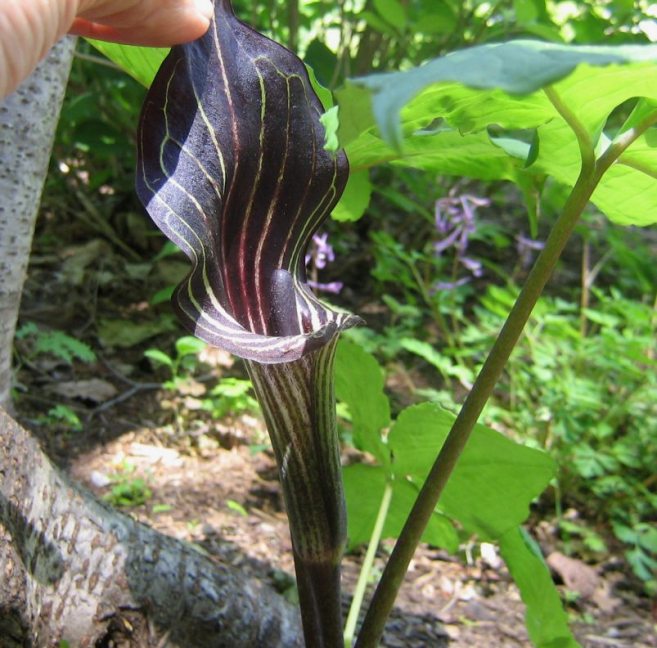
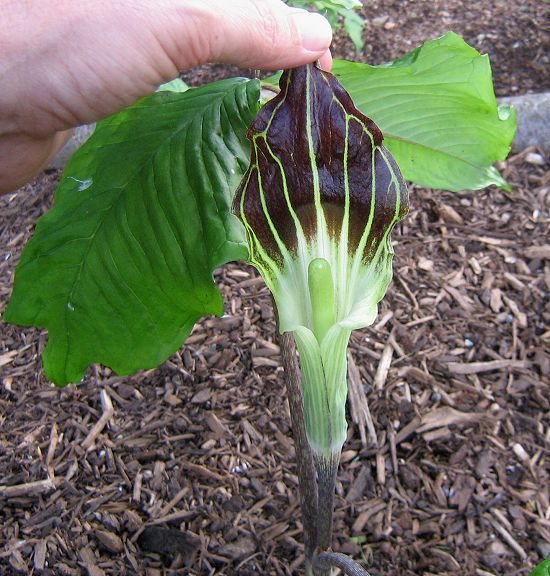

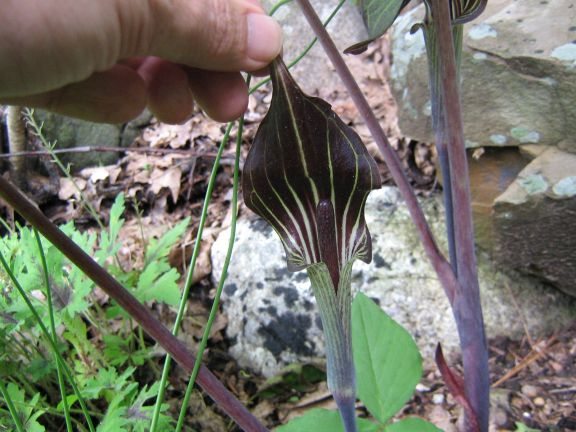
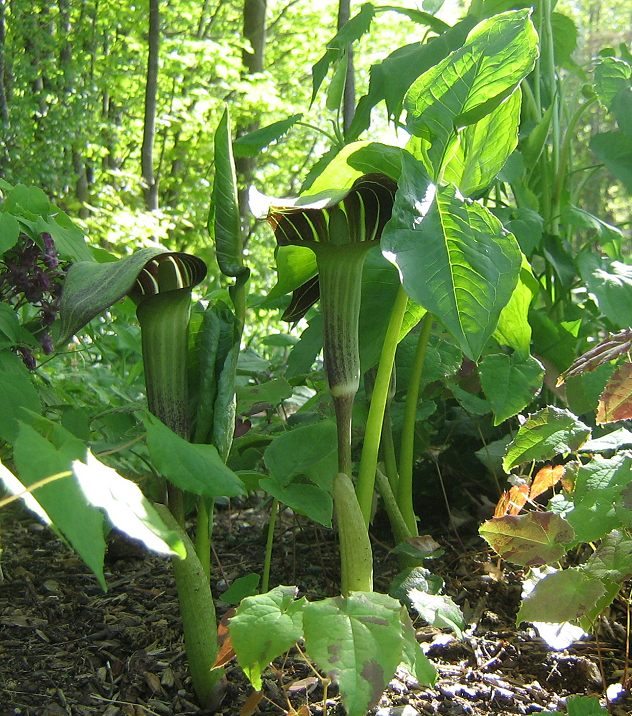
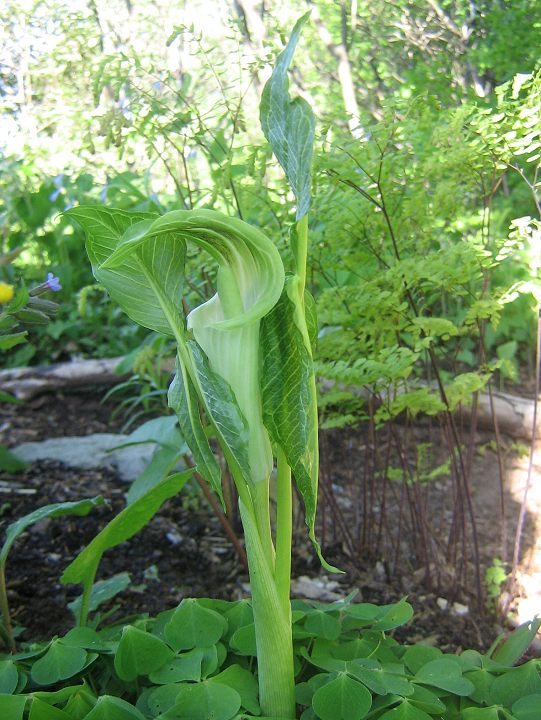
Comments
Mark McDonough
Re: Arisaema 2010
Fri, 04/09/2010 - 7:55pmJust emerging is a variable hybrid between Arisaema amurense (itself rather variable) and A. tashiroi, the latter a slender plant with distinctive snake-skin marked leaf sheathes. The hybrids are much shorter and more stout than the slender A. tashiroi, but inherit the richly colored stems.
Mark McDonough
Re: Arisaema 2010
Fri, 04/09/2010 - 8:02pmFollowing up on my post about Arisaema amurense x tashiroi hybrids, here is more information and a photo essay.
I grow two forms of A. amurense, a robust one with green brownish-tinged flower (which the hybrids most resemble) and smaller all-green flowered ones, and rather close by I grew A. tashiroi. A. kishidae was also there but that one died out a few years ago, however it remains a possibility this species is actually one of the parents... either parent could be responsible for the snake-skin marbled leaf sheathes that is not present on A. amurense. I have sinced moved my A. tashiroi, where it seems happier and grows taller too. I can post photos of both the hybrid plants flowering in 2009, along with A. tashiroi in 2009... will do so later on today.
photos 1-5 A. tashiroi
photos 6-7 A. amurense - robust form, with brownish flowers
photos 8-10 A. amurense x tashiroi, emerging flowers and foliage
photos 11-14 (in a second batch) A. amurense x tashiroi, full flower and foliage, last photo shows fruit.
Note: the robust A. amurense has flowers that smell badly of wet dog. Interestingly, the A. amurense x tashiroi hybrid has flowers with the same bad smell.
Mark McDonough
Re: Arisaema 2010
Fri, 04/09/2010 - 8:03pm2nd batch of Arisaema amurense x tashiroi
Mark McDonough
Re: Arisaema 2010
Fri, 04/09/2010 - 8:10pmFor North American gardeners reading this, please post your photos of local or garden variety Arisaema triphyllum, I'd love to see them... who doesn't love Jack-in-the-Pulpit plants and their amazing diversity. For members at large, post any interesting Arisaema photos, it is a huge, diverse, and intriguing genus!
USDA distribution map for A. triphyllum:
http://plants.usda.gov/java/profile?symbol=ARTR
Trond Hoy
Re: Arisaema 2010
Fri, 04/09/2010 - 11:07pmI agree, Mark, although I got interested in Arisaema just recently. I grow a couple in my garden but as usual without names! I had 7 pots of seedlings in my cold greenhouse this winter and unfortunately some of them froze to death in this exceptionally cold (for me) winter. All the pots froze solid before I noticed it. Maybe they had fared better in the soil. I haven't considered acquiring triphyllum, it looked pale and uninteresting but your pictures have opened my eyes to that species too! When I think of it I have no pictures of mine plants. Arisaema is very late in germinating here so you have to wait for that.
Todd Boland
Re: Arisaema 2010
Sat, 04/10/2010 - 4:42amNice expose on Arisaema Mark. No signs of mine yet but then they generally don't show until late May in my area. I have loads of triphyllum, 2 whose tags I lost and have yet to bloom and a sikkokianum which is my fav.
Richard T. Rodich
Re: Arisaema 2010
Sat, 04/10/2010 - 8:35pmSorry, I just can't get excited about A. triphyllum. It's too much of a thug here, and since my older brother though it would be a good idea to plant some in my parent's woods, unattended, I have been battling the take-over ever since.
I do grow a tentatively identified Arisaema franchetianum, which seems to grow to adulthood and bloom for 2 or 3 years, never to return. But offsets from stolons(?) seem to assure its survival here.
Mark McDonough
Re: Arisaema 2010
Sat, 04/10/2010 - 8:51pmThat's what is amazing about gardening; the differences in how plants behave in varying areas. Growing up in Massachusetts, the 'outskirts" of my parents yard were filled with A. triphyllum, but I would never have considered it a thug that would take over the yard or wild property... it was just here and there, as was Trillium cernuum. In my 23 years here, it has never shown any signs of running amok, and it is mostly what I have planted that shows up.
I have never grown A. franchetianum, but I love all these Arisaema... Plant Delights Nursery lists this as a Zone 7 plant (tender), so it is interesting you can get it to a flowering point and then it disappears, but at least offsets survive for you. So, I'm assuming you don't get seed?
Richard T. Rodich
Re: Arisaema 2010
Sun, 04/11/2010 - 8:31pmNo seed yet, although there's only been maybe two times they could have. The plant is very tall and seeming sturdy, but not very. In the five or six years that it has bloomed, most of the time something happens - a storm or animal that knocks it over and breaks the stem. Last year the mature bulb did not emerge, and I don't think the offsets will be large enough to bloom this season.
Mark McDonough
Re: Arisaema 2010
Sun, 04/11/2010 - 9:08pmHang in there. I will post on a monster tall form of Arisaema heterophyllum I've grown for the last 10 years, growing each year to 6' tall, never setting seed. Then in 2009, after the flowering stem fell over, I didn't bother stake it up, and maybe with ground-crawly bugs, the flower got fertilized and set seed. The seed was very late to ripen, and in December got encased in snow and ice. I have pictures after I chopped it out of the ice, and gathered the seed and cleaned it, then sowed seed in winter, and after a decade gone by, I now have 3 seedlings... expecting more to show up.
Bowden (not verified)
Re: Arisaema 2010
Thu, 04/29/2010 - 7:31pmMy Arisaema heterophyllum is large as well, 4-5' tall. It seeds around quite a bit, here is a photo of seedlings growing amidst a clump of Deinanthe bifida. I'll have to dig them out and find them a better spot. I'll post a photo when the mature plants are up.
My Arisaema amurense is the green flowered form. I've never noticed seed heads, but maybe the young plants come from bulb offsets. This year the leaves look a little odd -all crinkled.
My clump of Arisaema ringens is becoming quite impressive, I've had it about 12 years. I think it's at its most dramatic before the leaves have completely unfurled, but I didn't get the camera out in time.
Mark McDonough
Re: Arisaema 2010
Fri, 04/30/2010 - 6:34amPaul, that's one mighty impressive clump of A. ringens!!! :o How old is that clump? One of my favorite species. I had the all green and white flowered form for many years, but it NEVER increased, then it perished suddenly one year, in an area of the garden I struggle with voles/moles tunneling. A couple years ago I received the stunning black-rimmed form, which is the one to get. Just checked and it has sprouted, poking it's nose through the soil.
I grow a several forms of A. amurense, a couple forms are in flower now. Every year, they make very showy red-orange seed heads, some older photos uploaded here. Regarding some of your plants having leaves looking odd and crinkled, that is worrisome, I wonder if your plants are getting the rust that can afflict Arisaema. This year, a number of my Arisaema are heavily infected, on an amurense form, and on sikokianum. :(
Interesting that you're getting A. heterophyllum youngsters but haven't noticed any seed heads (hard to miss, usually bright orange-red), so maybe as you say, they are offsets? It's good that your getting young ones, I worried that I would eventually lose mine, because it refused to set viable seed for nearly 10 years then suddenly condescended to make seed last year, which are coming up now.
Richard T. Rodich
Re: Arisaema 2010
Fri, 04/30/2010 - 3:00pmAnd the Smilacina berries are quite hefty too. Our wild Smilacina racemosa produces berries readily, but the large spray you have pictured doesn't happen here. Oh, the Ariseama are nice too. Heehee. ;D
Bowden (not verified)
Re: Arisaema 2010
Sun, 05/02/2010 - 8:29pmMark, The A. ringens clump is about 10 years old. I'm don't know what makes it so happy. An A. sikokianum right next to it only lasted about 3 years.
My A. heterophyllum does make seed heads. I donate them sometimes, other times I've let them fall to the ground, hence the seedlings.
I think I would have noticed the Arisaema amurense seedheads, but maybe I missed them. I looked at the undersides of the crinkled leaves and don't see any of the orange spots that I read on the internet indicate rust. Do the spots appear later on? I'm wondering if the leaf could be damaged by aphids. Sometimes when I accidentally dig up an Arisaema corm (is it a corm or a tuber?) planting or moving a plant nearby, I find the corm covered with grey aphids. Now that we have the forum I can post a picture if I find this again.
Trond Hoy
Re: Arisaema 2010
Thu, 06/03/2010 - 6:35amAt last my first Arisaema this year chose to flower weeks later than normal. Species is unknown but it is from China I presume!